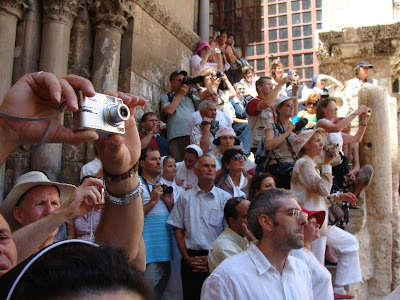The arrival of a Patriarch.










On the same day that I attended the Greek Orthodox service of Orthros at the Church of the Holy Sepulchre, I witnessed a historic event in the life of the Roman Catholic Church in the Holy Land: the enthronement of a new Latin Patriarch. After twenty years as Latin Patriarch of Jerusalem, Archbishop Michel Sabbah officially retired on June 21st and was succeeded by Archbishop Fouad Twal, his coadjutor since 2005. The following afternoon, Archbishop Twal marked the beginning of his service as Latin Patriarch with his solemn entry into the Church of the Holy Sepulchre, accompanied by bishops, clergy and seminarians of the Latin Patriarchate as well as assorted ecumenical dignitaries and laypeople.
The photos presented above should provide some sense of what the solemn entry of a new Latin Patriarch into the Church of the Holy Sepulchre looks like. The afternoon's events began with a procession from the offices of the Latin Patriarchate to the Holy Sepulchre; as shown in the first photo from the top, the streets along the route were festooned with paper flags bearing the emblem of the Latin Patriarchate. While the procession slowly covered the short distance from the Latin Patriarchate to the Holy Sepulchre, a diverse group waited to greet the Patriarch at the entrance of the holiest site in Christendom. Included in the group (second photo) were Franciscan Friars of the Custodia Terrae Sanctae as well as the fez-clad Palestinian laymen who act as enforcers of the status quo regarding the division of the Holy Sepulchre among several Christian communities. In the third photo, representatives of three of these communities - Latin, Greek and Armenian - smile and laugh in an apparent display of ecumenical good humor. The man standing before the church doors in the fourth photo is Wajeeh Nuseibeh, the Muslim doorkeeper of the Holy Sepulchre. The privilege of opening and closing the doors to the church has been the exclusive prerogative of the Nuseibeh family for centuries; keeping this task in Muslim hands plays a role in maintaining the fragile balance of power among the different churches that claim the right to worship in the Holy Sepulchre.
The multitude awaiting Archbishop Twal's arrival also included a fair number of tourists (fifth photo) as well as unruly hordes of press photographers and reporters. When the new Patriarch finally appeared, marching beneath a canopy held aloft by various attendants (sixth photo), he was preceded by a retinue that included numerous bishops and clergy (seventh photo) and a large number of seminarians from the Latin Patriarchate (eighth photo). The crush of people was such that when Archbishop Twal reached the doors of the Holy Sepulchre (ninth photo), very few people were actually able to follow him inside. Instead, the multitude stood gaping at the entrance in an effort to see what was going on within the darkened confines of the church (tenth photo). As one among the multitude, I felt very lucky to watch history unfold at close quarters. AMDG.


0 Comments:
Post a Comment
<< Home